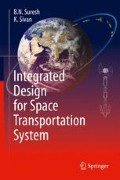Abstract
During the entire phase of space transportation system mission, from lift-off till satellite injection, various constraints and requirements applicable not only to the mission but also to vehicle systems, ground systems, range safety and tracking systems are to be satisfied. Considering these constraints and requirements, an optimum feasible trajectory has to be designed to meet the mission requirements. The mission design process involves the utilization of the available energy for realizing the defined orbital mission by devising suitable strategies of directing the energy along the suitable path and sequencing the energy addition process. Optimum mission design strategies have to be arrived at to achieve the maximum performance, ensuring the defined mission under nominal and off-nominal flight environments and system parameter dispersions. The trajectory shaping satisfying vehicle loads and radio visibility for continuous tracking coverage during ascent phase are other essential parts of mission design. There are number of constraints like thermal loads on the spacecraft, the vehicle subsystems during ascent phase and jet plumes of reaction control system thrusters interacting with the spacecraft. The passivation requirements of the final stage after spacecraft separation are to be carefully worked out. Another important aspect of mission design is to finalize the flight events/sequences which generate various commands to separate the stages and to initiate the subsequent flight events. In such complex systems close interactions among various disciplines exist, and the mission design requires several iterations. In this chapter all these aspects of mission design are discussed in detail and various activities involved in mission design process explained. The mission design strategies and importance of the same for the vehicle design process are included. Mission requirements, constraints, design and analysis aspects and trajectory design constraints during various phases of trajectory are presented. Mission sequence design considerations and all other mission-related studies like satellite orientation requirements for multiple satellite launch and passivation requirements to ensure the safety of the spent stage are also highlighted.
Access this chapter
Tax calculation will be finalised at checkout
Purchases are for personal use only
Bibliography
Wiesel, W.E.: Spaceflight Dynamics. McGraw-Hill, New York (1997)
Hammond, W.E.: Design Methodologies for Space Transportation Systems, AIAA Education Series, Reston (2001)
Wertz, J.R., Larson, W.J. (eds.): Space Mission Analysis and Design. Microcosm, Torrance (1999)
Adimurthy, V.: Launch vehicle trajectory optimization including rotational dynamics”. Journal of Spacecraft and Rockets 13, 59–61 (1976)
Adimurthy, V.: Launch vehicle trajectory optimization”. Acta Astronautica 15, 845–850 (1987)
Adimurthy, V.: Trajectory and mission design of launch vehicles”. In: Ramakrishnan, C.V. (ed.) Current trends in Engineering practice. Lectures under the Distinguished Visiting Professorship Scheme of Indian National Academy of Engineering, pp. 417–436. Narosa Publishing House, New Delhi (2006). ISBN 81-7319-689-3
Thomson, W.T.: Introduction to Space Dynamics. Dover Publications, New York (1986)
Isakowitz, S.J.: AIAA International Reference Guide to Space Launch Systems, 2nd edn. American Institute of Aeronautics and Astronautics, Washington, DC (1995)
Vinti, J.P., Der, G.J., Bonavito, N.L. (eds.): Orbital and Celestial Mechanics. Progress in Astronautics and Aeronautics”. AIAA, Reston, VA (1998)
Turner, M.J.L.: Rocket and Spacecraft Propulsion: Principles, Practice and New Developments. Springer, Heidelberg/New York (2006)
Leitmann, G.: Optimization Techniques, pp. 1–31. Academic, New York (1962)
Ehricke, E.A.: Space flight, Vol.-II, Dynamics. Van Nostrand, New York (1962)
Brown, C.D.: Spacecraft Mission Design. AIAA, Reston (1992)
Cornelisse, J.J., Schoyer, H.F.R., Wakker, K.F.: Rocket Propulsion and Spaceflight Dynamics. Pitman Publishing Ltd, San Francisco (1979)
Pocha, J.J.: An introduction to Mission Design for Geostationary Satellites. D.Riedel Publishing Company, Boston (1987)
Rheinfurth, M.H.: The Alleviation of Aerodynamic Loads on Rigid Space Vehicles. NASA TM X-53397, Mrshall Space Flight Centre, Huntsville (1966)
Ernsberger, G.: Wind Biasing Techniques for use in obtaining Load Relief. NASA TMX-64604 (1971)
Sinclair, A.J., Flowers, G.T.: Coupled Flight-Dynamic and Low-Order Aero-elastic Model for a Slender Launch Vehicle
Wertz, J.R., Larson, W.L. (eds.): Space Mission Analysis and Design, 3rd edn. Microcosm and Kluwer, El Segundo (1999)
Author information
Authors and Affiliations
Rights and permissions
Copyright information
© 2015 Springer India
About this chapter
Cite this chapter
Suresh, B.N., Sivan, K. (2015). Mission Design. In: Integrated Design for Space Transportation System. Springer, New Delhi. https://doi.org/10.1007/978-81-322-2532-4_7
Download citation
DOI: https://doi.org/10.1007/978-81-322-2532-4_7
Publisher Name: Springer, New Delhi
Print ISBN: 978-81-322-2531-7
Online ISBN: 978-81-322-2532-4
eBook Packages: EngineeringEngineering (R0)

